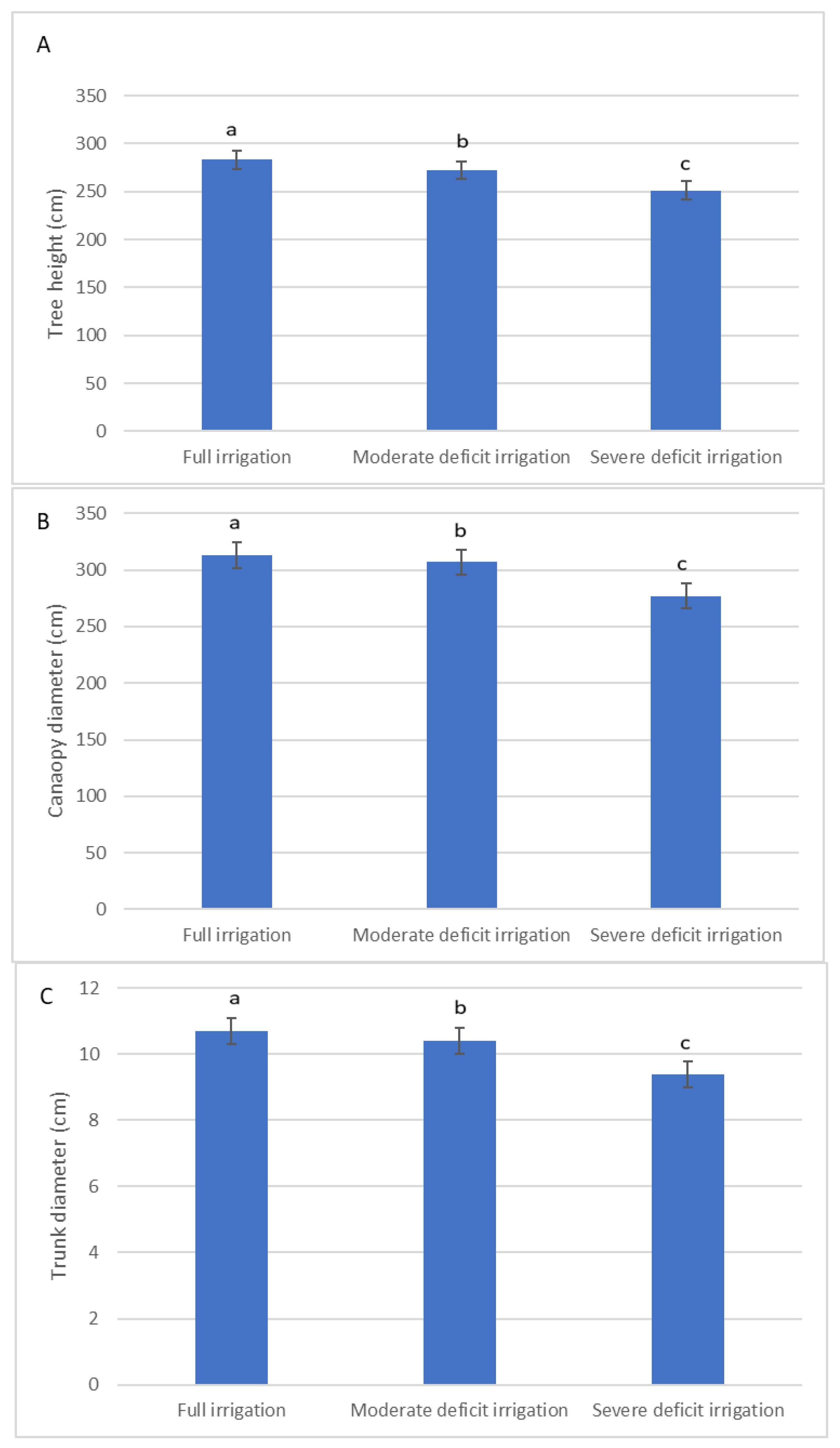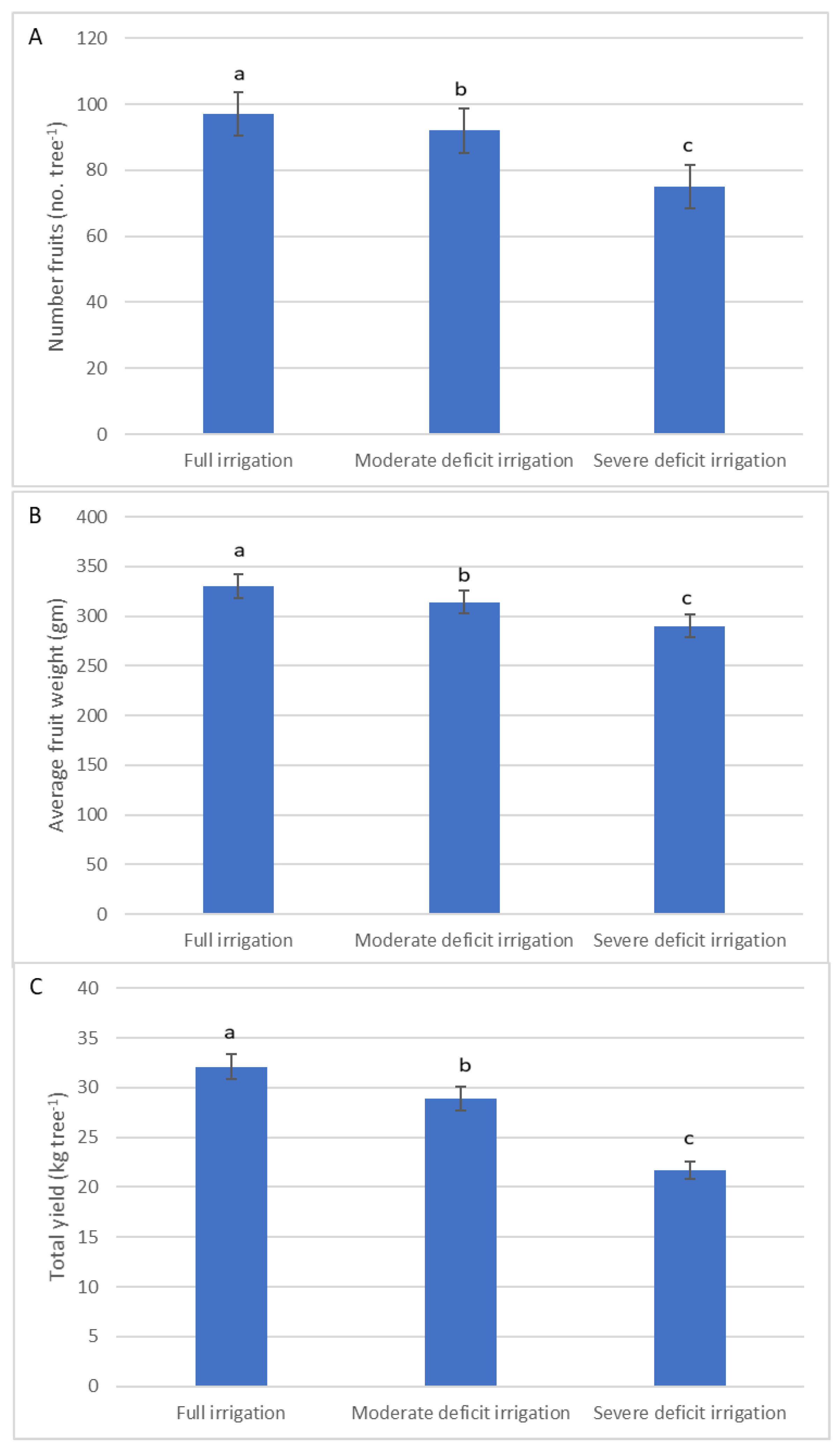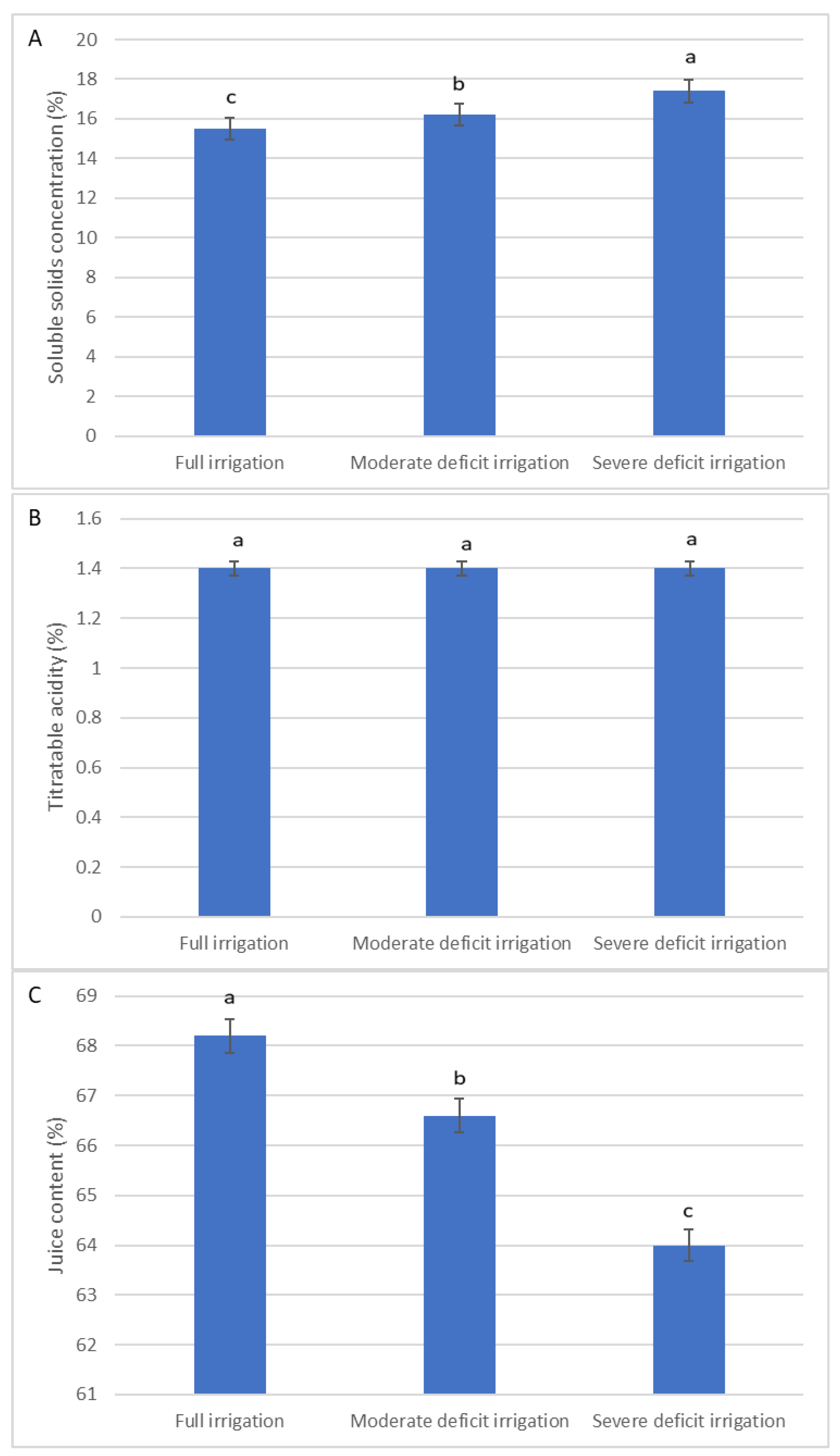Effects of Deficit Irrigation on Growth, Yield, and Quality of Pomegranate (Punica granatum) Grown in Semi-Arid Conditions
Abstract
:1. Introduction
2. Materials and Methods
2.1. Study Area Description
2.2. Experimental Design
2.3. Irrigation Scheduling and Management
2.4. Fertilization and Soil Management
2.5. Data Collection
2.6. Statistical Analysis
3. Results
3.1. Growth Parameters
3.2. Yield Components
3.3. Fruit Quality Parameters
3.4. Water Use Efficiency (WUE)
3.5. Water Economics and Productivity
3.5.1. Total Yield and Income
3.5.2. Irrigation Costs and Water Use
3.5.3. Net Profit
3.5.4. Water Productivity
4. Discussion
4.1. Growth Parameters
4.2. Yield Components
4.3. Fruit Quality
4.4. Water Use Efficiency (WUE)
4.5. Implications for Sustainable Agriculture
5. Conclusions
Author Contributions
Funding
Data Availability Statement
Acknowledgments
Conflicts of Interest
References
- Allam, M.N.; Allam, G.I. Water resources in Egypt: Future challenges and opportunities. Water Int. 2007, 32, 205–218. [Google Scholar] [CrossRef]
- El-Sadek, A. Water desalination: An imperative measure for water security in Egypt. Desalination 2010, 250, 876–884. [Google Scholar] [CrossRef]
- Qureshi, A.S.; McCornick, P.G.; Sarwar, A.; Sharma, B.R. Challenges and prospects of sustainable groundwater management in the Indus Basin, Pakistan. Water Resour. Manag. 2010, 24, 1551–1569. [Google Scholar] [CrossRef]
- Geerts, S.; Raes, D. Deficit irrigation as an on-farm strategy to maximize crop water productivity in dry areas. Agric. Water Manag. 2009, 96, 1275–1284. [Google Scholar] [CrossRef]
- Fereres, E.; Soriano, M.A. Deficit irrigation for reducing agricultural water use. J. Exp. Bot. 2007, 58, 147–159. [Google Scholar] [CrossRef]
- Elmenofy, H.M.; Hatterman-Valenti, H.M.; Hassan, I.F.; Mahmoud, M.M.A. Effects of Deficit Irrigation and Anti-Stressors on Water Productivity, and Fruit Quality at Harvest and Stored ‘Murcott’ Mandarin. Horticulturae 2023, 9, 787. [Google Scholar] [CrossRef]
- Chaves, M.M.; Zarrouk, O.; Francisco, R.; Costa, J.M.; Santos, T.; Regalado, A.P.; Rodrigues, M.L.; Lopes, C.M. Grapevine under deficit irrigation: Hints from physiological and molecular data. Ann. Bot. 2010, 105, 661–676. [Google Scholar] [CrossRef]
- Shailendra, A.; Narendra, A. The effect of trickle irrigation on growth yield and quality of pomegranate (Punica granatum L.) in cv. Ganesh in Chhattisgarth region. J. Agric. Sci. 2005, 39, 175–181. [Google Scholar]
- Tarantino, A.; Frabboni, L.; Disciglio, G. Water-Yield Relationship and Vegetative Growth of Wonderful Young Pomegranate Trees under Deficit Irrigation Conditions in Southeastern Italy. Horticulturae 2021, 7, 79. [Google Scholar] [CrossRef]
- Melgarejo, P.; Salazar, D.M.; Artés, F. Organic pomegranate production: Effects of irrigation on fruit yield. HortScience 2000, 35, 423–427. [Google Scholar]
- Mirdehghan, S.H.; Rahemi, M. Seasonal changes of mineral nutrients and phenolics in pomegranate. Sci. Hortic. 2007, 111, 120–127. [Google Scholar] [CrossRef]
- Holland, D.; Hatib, K.; Bar-Ya’akov, I. Pomegranate: Botany, horticulture, breeding. Hortic. Rev. 2009, 35, 127–191. [Google Scholar] [CrossRef]
- Martínez, J.J.; Hernández, F.; Melgarejo, P. Improvement of fruit quality in pomegranate through regulated deficit irrigation. Sci. Hortic. 2009, 120, 100–106. [Google Scholar] [CrossRef]
- Patil, S.R.; Thorat, V.A.; Golegaonkar, P.G.; Reddy, P.S. Influence of deficit irrigation on pomegranate yield and quality. J. Hortic. Sci. 2014, 56, 237–245. [Google Scholar]
- Yaghoobi, S.R.; Moghadam, H.A.; Karimi, S. Response of pomegranate fruit quality to deficit irrigation. J. Agric. Sci. Tech. 2012, 14, 933–944. [Google Scholar]
- Hassan, I.F.; Ajaj, R.; Gaballah, M.S.; Ogbaga, C.C.; Kalaji, H.M.; Hatterman-Valenti, H.M.; Alam-Eldein, S.M. Foliar Application of Nano-Silicon Improves the Physiological and Biochemical Characteristics of ‘Kalamata’ Olive Subjected to Deficit Irrigation in a Semi-Arid Climate. Plants 2022, 11, 1561. [Google Scholar] [CrossRef]
- Intrigliolo, D.S.; Castel, J.R. Response of grapevine cv. ‘Tempranillo’ to timing and amount of irrigation: Water relations, vine growth, yield and berry and wine composition. Irrig. Sci. 2010, 28, 113–125. [Google Scholar] [CrossRef]
- Gómez-Bellot, J.; Parra, A.; Nortes, P.; Alarcón, J.J.; Ortuño, M.F. Searching for a deficit irrigation strategy to save water and improve fruit quality without compromising pomegranate production. Sci. Hortic. 2024, 324, 112631. [Google Scholar] [CrossRef]
- Marsal, J.; Gelly, M.; Mata, M.; Arbonés, A.; Rufat, J.; Girona, J. Postharvest regulated deficit irrigation in ‘Summit’ sweet cherry: Effects on vegetative growth and fruit quality. Agric. Water Mgmt. 2011, 98, 516–522. [Google Scholar]
- Hegazy, A.K.; Fahmy, G.M.; Ali, M.I.; Gomaa, N.H. Vegetation diversity in natural and agro-ecosystems of arid lands. Comm. Ecol. 2004, 5, 163–176. [Google Scholar] [CrossRef]
- Allen, R.G.; Pereira, L.S.; Raes, D.; Smith, M. Crop evapotranspiration-Guidelines for computing crop water requirements-FAO Irrigation and drainage paper 56. Fao Rome 1998, 300, D05109. [Google Scholar]
- Pajura, R. Composting Municipal Solid Waste and Animal Manure in Response To The Current Fertilizer Crisis - A Recent Review. Science of The Total Environment 2024, 912, 169221. [Google Scholar] [CrossRef]
- Smith, M.; Allen, R.G.; Pereira, L.S. Revised FAO methodology for crop water requirements. Irrig. Drain. 2000, 49, 97–110. [Google Scholar] [CrossRef]
- Chaves, M.M.; Flexas, J.; Pinheiro, C. Photosynthesis under drought and salt stress: Regulation mechanisms from whole plant to cell. Ann. Bot. 2010, 103, 551–560. [Google Scholar] [CrossRef]
- Egyptian Meteorological Authority (EMA). Climatic Data for the El-Khatatba Region in Egypt: Means for the Period 2023–2024. 2024. Available online: http://nwp.gov.eg/ (accessed on 2 November 2024).
- Martínez, J.J.; Melgarejo, P.; Hernández, F. Irrigation regime effects on pomegranate (Punica granatum L.) fruit quality. Agric. Water Mgmt. 2009, 96, 1633–1639. [Google Scholar]
- Walker, W.R.; Allen, R.G.; Jensen, M.E. Model for predicting evapotranspiration and irrigation scheduling for pomegranate. Agric. Water Manag. 2006, 82, 138–157. [Google Scholar]
- Lurie, S.; Friedman, H.; Weksler, A. Effects of irrigation and harvesting time on pomegranate fruit quality. Postharv. Biol. Technol. 2012, 65, 162–168. [Google Scholar] [CrossRef]
- Mena, P.; Galindo, A.; Collado-González, J.; Ondoño, S.; GarcíaViguera, C.; Ferreres, F.; Torrecillas, A.; Gil-Izquierdo, A. Sustained deficit irrigation affects the colour and phytochemical characteristics of pomegranate juice. J. Sci. Food Agric. 2012, 93, 1922–1927. [Google Scholar] [CrossRef]
- Porras-Jorge, R.; Aguilar, J.M.; Baixauli, C.; Bartual, J.; Pascual, B.; Pascual-Seva, N. Effect of Deficit Irrigation on Agronomic and Physiological Performance of Pomegranate (Punica granatum L.). Plants 2025, 14, 164. [Google Scholar] [CrossRef]
- Bugueño, F.; Livellara, N.; Varas, F.; Undurraga, P.; Castro, M.; Salgado, E. Responses of young Punica granatum plants under four different water regimes. Cienc. Inv. Agric. 2016, 43, 49–56. [Google Scholar] [CrossRef]
- Meshram, D.T. Response of Pomegranate (Punica Granatum L.) to Deficit Irrigation System under Field Conditions. J. Agrometeor. 2020, 22, 126–135. [Google Scholar]
- Intrigliolo, D.S.; Bonet, L.; Nortes, P.A.; Puerto, H.; Nicolas, E.; Bartual, J. Pomegranate trees performance under sustained and regulated deficit irrigation. Irrig. Sci. 2013, 31, 959–970. [Google Scholar] [CrossRef]
- Leal, L.d.e.S.G.; Marinho, L.B.; Macário de, G.; Pereira dos, M.É.; Clemente, V.D.; Aires, E.S.; Figueiredo Neto, A. Irrigation Management of Punica Granatum in the Sub-Middle São Francisco River Valley: Morphophysiological Aspects. Com. Sci. 2024, 15, e4023. [Google Scholar] [CrossRef]
- Centofanti, T.; Banuelos, G.S.; Wallis, C.; Ayars, J.E. Deficit irrigation strategies and their impact on yield and nutritional quality of pomegranate fruit. Fruits 2017, 72, 47–54. [Google Scholar] [CrossRef] [PubMed]
- Nasrabadi, M.; Ramezanian, A.; Eshghi, S.; Sarkhosh, A. Chilling and heat requirement of pomegranate (Punica granatum L.) trees grown under sustained deficit irrigation. Sci. Hortic. 2020, 263, 109117. [Google Scholar] [CrossRef]
- Laribi, A.; Palou, L.; Intrigliolo, D.; Nortes, P.; Rojas-Argudo, C.; Taberner, V.; Bartual, J.; Pérez-Gago, M.B. Effect of sustained and regulated deficit irrigation on fruit quality of pomegranate cv. ‘Mollar De Elche’ at harvest and during cold storage. Agric. Water Manag. 2013, 125, 61–70. [Google Scholar] [CrossRef]
- Aydin, Y.; Mikail, N.; Pakyürek, M.; Saltuk, B.; Seven, M. Water-yield relationship of Zivzik pomegranate under deficit irrigation conditions. Land Reclam. Earth Obs. Surv. Environ. Eng. 2017, 6, 81–86. [Google Scholar]
- Dinc, N.; Aydinsakir, K.; Isik, M.; Bastug, R.; Ari, N.; Sahin, A.; Buyuktas, D. Assessment of different irrigation strategies on yield and quality characteristics of drip irrigated pomegranate. Irrig. Sci. 2018, 36, 87–96. [Google Scholar] [CrossRef]
- Martínez-Nicolás, J.J.; Galindo, A.; Griñán, I.; Rodríguez, P.; Cruz, Z.N.; Martínez-Font, R.; Carbonell-Barrachina, A.A.; Nouri, H.; Melgarejo, P. Irrigation Water Saving during Pomegranate Flowering and Fruit Set Period Do Not Affect Wonderful and Mollar de Elche Cultivars Yield and Fruit. Composition. Agric. Water Manag. 2019, 226, 105781. [Google Scholar] [CrossRef]
- Volschenk, T. Effect of Water Deficits on Pomegranate Tree Performance and Fruit Quality—A Review. Agric. Water Manag. 2021, 246, 106499. [Google Scholar] [CrossRef]
- Haleem, A.Y.; Ghieth, W.M.; Hegazy, A.A.H. Performance of Some Pomegranate Cultivars under Different Irrigation levels in North Sinai. Middle East J. Agric. Res. 2021, 9, 1021–1031. [Google Scholar] [CrossRef]





| Parameter | Unit | Value |
|---|---|---|
| pH | - | 7.8 |
| Organic matter | % | 0.5 |
| Electrical conductivity (EC) | dS/m | 1.2 |
| Nitrogen (N) | ppm | 35 |
| Phosphorus (P) | ppm | 20 |
| Potassium (K) | ppm | 150 |
| Zinc (Zn) | ppm | 2.5 |
| Iron (Fe) | ppm | 5.0 |
| Soil texture | - | Sandy |
| Parameter | Unit | Value |
|---|---|---|
| pH | - | 7.5 |
| Electrical conductivity (EC) | dS/m | 1.5 |
| Total dissolved solids (TDS) | mg/L | 960 |
| Sodium (Na+) | mg/L | 180 |
| Potassium (K+) | mg/L | 12 |
| Calcium (Ca2+) | mg/L | 80 |
| Magnesium (Mg2+) | mg/L | 40 |
| Chloride (Cl−) | mg/L | 300 |
| Sulfate (SO42−) | mg/L | 200 |
| Bicarbonate (HCO3−) | mg/L | 150 |
| Month | Average Temperature (°C) | Relative Humidity (%) | Solar Radiation (kW h m−² day−1) | Rainfall (mm) |
|---|---|---|---|---|
| March | 22 | 50 | 6.2 | 2 |
| April | 25 | 45 | 6.8 | 1 |
| May | 30 | 40 | 7.2 | 0 |
| June | 34 | 35 | 7.6 | 0 |
| July | 36 | 30 | 7.8 | 0 |
| August | 35 | 32 | 7.5 | 0 |
| September | 31 | 40 | 6.9 | 1 |
| October | 28 | 45 | 6.4 | 2 |
| Treatment | Total Yield (kg tree−1) | Income (EGP tree−1) | Irrig. Cost (EGP tree−1) | Net Profit (EGP tree−1) | Water Productivity (EGP m−3) |
|---|---|---|---|---|---|
| FI | 32.1 | 4800 | 1000 | 3800 | 253.3 |
| MDI | 28.9 | 4335 | 750 | 3585 | 318.7 |
| SDI | 21.7 | 3255 | 500 | 2755 | 367.3 |
Disclaimer/Publisher’s Note: The statements, opinions and data contained in all publications are solely those of the individual author(s) and contributor(s) and not of MDPI and/or the editor(s). MDPI and/or the editor(s) disclaim responsibility for any injury to people or property resulting from any ideas, methods, instructions or products referred to in the content. |
© 2025 by the authors. Licensee MDPI, Basel, Switzerland. This article is an open access article distributed under the terms and conditions of the Creative Commons Attribution (CC BY) license (https://creativecommons.org/licenses/by/4.0/).
Share and Cite
Hassan, I.F.; Ajaj, R.; Abd El-Khalek, A.F.; Alam-Eldein, S.M.; Gaballah, M.S.; Athar, H.u.R.; Hatterman-Valenti, H.M. Effects of Deficit Irrigation on Growth, Yield, and Quality of Pomegranate (Punica granatum) Grown in Semi-Arid Conditions. Horticulturae 2025, 11, 101. https://doi.org/10.3390/horticulturae11010101
Hassan IF, Ajaj R, Abd El-Khalek AF, Alam-Eldein SM, Gaballah MS, Athar HuR, Hatterman-Valenti HM. Effects of Deficit Irrigation on Growth, Yield, and Quality of Pomegranate (Punica granatum) Grown in Semi-Arid Conditions. Horticulturae. 2025; 11(1):101. https://doi.org/10.3390/horticulturae11010101
Chicago/Turabian StyleHassan, Islam F., Rahaf Ajaj, Ahmed F. Abd El-Khalek, Shamel M. Alam-Eldein, Maybelle S. Gaballah, Habib ur Rehman Athar, and Harlene M. Hatterman-Valenti. 2025. "Effects of Deficit Irrigation on Growth, Yield, and Quality of Pomegranate (Punica granatum) Grown in Semi-Arid Conditions" Horticulturae 11, no. 1: 101. https://doi.org/10.3390/horticulturae11010101
APA StyleHassan, I. F., Ajaj, R., Abd El-Khalek, A. F., Alam-Eldein, S. M., Gaballah, M. S., Athar, H. u. R., & Hatterman-Valenti, H. M. (2025). Effects of Deficit Irrigation on Growth, Yield, and Quality of Pomegranate (Punica granatum) Grown in Semi-Arid Conditions. Horticulturae, 11(1), 101. https://doi.org/10.3390/horticulturae11010101










